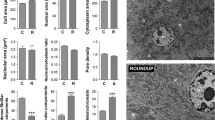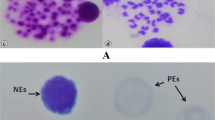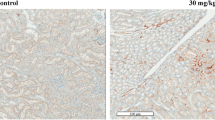Abstract
Enzymes that metabolize xenobiotics (XME) are well recognized in experimental models as representative indicators of organ detoxification functions and of exposure to toxicants. As several in vivo studies have shown, uranium can alter XME in the rat liver or kidneys after either acute or chronic exposure. To determine how length or level of exposure affects these changes in XME, we continued our investigation of chronic rat exposure to depleted uranium (DU, uranyl nitrate). The first study examined the effect of duration (1–18 months) of chronic exposure to DU, the second evaluated dose dependence, from a level close to that found in the environment near mining sites (0.2 mg/L) to a supra-environmental dose (120 mg/L, 10 times the highest level naturally found in the environment), and the third was an in vitro assessment of whether DU exposure directly affects XME and, in particular, CYP3A. The experimental in vivo models used here demonstrated that CYP3A is the enzyme modified to the greatest extent: high gene expression changed after 6 and 9 months. The most substantial effects were observed in the liver of rats after 9 months of exposure to 120 mg/L of DU: CYP3A gene and protein expression and enzyme activity all decreased by more than 40 %. Nonetheless, no direct effect of DU by itself was observed after in vitro exposure of rat microsomal preparations, HepG2 cells, or human primary hepatocytes. Overall, these results probably indicate the occurrence of regulatory or adaptive mechanisms that could explain the indirect effect observed in vivo after chronic exposure.






Similar content being viewed by others
References
Bleise A, Danesi PR, Burkart W (2003) Properties, use and health effects of depleted uranium (DU): a general overview. J Environ Radioact 64(2–3):93–112
Brady HR, Kone BC, Brenner RM, Gullans SR (1989) Early effects of uranyl nitrate on respiration and K + transport in rabbit proximal tubule. Kidney Int 36(1):27–34
Carriere M, Avoscan L, Collins R et al (2004) Influence of uranium speciation on normal rat kidney (NRK-52E) proximal cell cytotoxicity. Chem Res Toxicol 17(3):446–452
Craft E, Abu-Qare A, Flaherty M, Garofolo M, Rincavage H, Abou-Donia M (2004) Depleted and natural uranium: chemistry and toxicological effects. J Toxicol Environ Health B Crit Rev 7(4):297–317
Dublineau I, Grandcolas L, Grison S et al (2007) Modifications of inflammatory pathways in rat intestine following chronic ingestion of depleted uranium. Toxicol Sci 98(2):458–468
Faber KN, Muller M, Jansen PL (2003) Drug transport proteins in the liver. Adv Drug Deliv Rev 55(1):107–124
Fent K (2003) Ecotoxicological problems associated with contaminated sites. Toxicol Lett 140–141:353–365
Gilman AP, Villeneuve DC, Secours VE et al (1998) Uranyl nitrate: 28-day and 91-day toxicity studies in the Sprague-Dawley rat. Toxicol Sci 41(1):117–128
Gueguen Y, Rouas C (2012) New data on uranium nephrotoxicity. Radioprotection 47(3):345–359. doi:10.1051/radiopro/2012015
Gueguen Y, Paquet F, Voisin P, Souidi M (2005) Effects of chronic contamination with depleted uranium on xenobiotic biotransformation enzymes in the rat. In: Medimond IP (ed) proceedings of the 14th international conference on cytochromes P450, pp 61–65. ISBN 88-7587-188-4
Gueguen Y, Mouzat K, Ferrari L et al (2006a) Cytochromes P450: xenobiotic metabolism, regulation and clinical importance. Ann Biol Clin (Paris) 64(6):535–548
Gueguen Y, Souidi M, Baudelin C et al (2006b) Short-term hepatic effects of depleted uranium on xenobiotic and bile acid metabolizing cytochrome P450 enzymes in the rat. Arch Toxicol 80(4):187–195. doi:10.1007/s00204-005-0027-3
Gueguen Y, Grandcolas L, Baudelin C et al (2007) Effect of acetaminophen administration to rats chronically exposed to depleted uranium. Toxicology 229(1–2):62–72. doi:10.1016/j.tox.2006.10.006
Gueguen Y, Rouas C, Leblond FA (2012) Kidney injury biomarkers. Nephrol Ther 8(3):146–155. doi:10.1016/j.nephro.2012.02.004
Honkakoski P, Negishi M (2000) Regulation of cytochrome P450 (CYP) genes by nuclear receptors. Biochem J 347(Pt 2):321–337
Hori R, Takano M, Okano T, Inui K (1985) Transport of p-aminohippurate, tetraethylammonium and d-glucose in renal brush border membranes from rats with acute renal failure. J Pharmacol Exp Ther 233(3):776–781
Igarashi Y, Yamakawa A, Ikeda N (1987) Plutonium and uranium in Japanese human tissues. Radioisotopes 36(9):433–439
Juntunen R (1991) Uranium and radon in wells drilled into bedrock in southern Finland. Report of investigation, geological survey of Finland 98
Kliewer SA, Willson TM (2002) Regulation of xenobiotic and bile acid metabolism by the nuclear pregnane X receptor. J Lipid Res 43(3):359–364
Krusekopf S, Roots I, Kleeberg U (2003) Differential drug-induced mRNA expression of human CYP3A4 compared to CYP3A5, CYP3A7 and CYP3A43. Eur J Pharmacol 466(1–2):7–12
La Touche YD, Willis DL, Dawydiak OI (1987) Absorption and biokinetics of U in rats following an oral administration of uranyl nitrate solution. Health Phys 53(2):147–162
Leblond F, Guevin C, Demers C, Pellerin I, Gascon-Barre M, Pichette V (2001) Downregulation of hepatic cytochrome P450 in chronic renal failure. J Am Soc Nephrol 12(2):326–332
Leggett RW (1989) The behavior and chemical toxicity of U in the kidney: a reassessment. Health Phys 57(3):365–383
Lestaevel P, Bussy C, Paquet F et al (2005) Changes in sleep-wake cycle after chronic exposure to uranium in rats. Neurotoxicol Teratol 27(6):835–840
Linares V, Belles M, Albina ML, Sirvent JJ, Sanchez DJ, Domingo JL (2006) Assessment of the pro-oxidant activity of uranium in kidney and testis of rats. Toxicol Lett 167(2):152–161
Lohr JW, Willsky GR, Acara MA (1998) Renal drug metabolism. Pharmacol Rev 50(1):107–141
Maruyama M, Matsunaga T, Harada E, Ohmori S (2007) Comparison of basal gene expression and induction of CYP3As in HepG2 and human fetal liver cells. Biol Pharm Bull 30(11):2091–2097
Michaud J, Naud J, Ouimet D, et al (2010) Reduced hepatic synthesis of calcidiol in Uremia. J Am Soc Nephrol:[Epub ahead of print]
Milgram S, Carriere M, Thiebault C, Malaval L, Gouget B (2008) Cytotoxic and phenotypic effects of uranium and lead on osteoblastic cells are highly dependent on metal speciation. Toxicology 250(1):62–69. doi:10.1016/j.tox.2008.06.003
Miller AC, Brooks K, Smith J, Page N (2004) Effect of the militarily-relevant heavy metals, depleted uranium and heavy metal tungsten-alloy on gene expression in human liver carcinoma cells (HepG2). Mol Cell Biochem 255(1–2):247–256
Mirto H, Henge-Napoli MH, Gibert R, Ansoborlo E, Fournier M, Cambar J (1999) Intracellular behaviour of uranium(VI) on renal epithelial cell in culture (LLC-PK1): influence of uranium speciation. Toxicol Lett 104(3):249–256
Moon YJ, Lee AK, Chung HC et al (2003) Effects of acute renal failure on the pharmacokinetics of chlorzoxazone in rats. Drug Metab Dispos 31(6):776–784
Moore MR (2004) A commentary on the impacts of metals and metalloids in the environment upon the metabolism of drugs and chemicals. Toxicol Lett 148(3):153–158
Ortega A, Domingo JL, Llobet JM, Tomas JM, Paternain JL (1989) Evaluation of the oral toxicity of uranium in a 4-week drinking-water study in rats. Bull Environ Contam Toxicol 42(6):935–941
Paquet F, Houpert P, Blanchardon E et al (2006) Accumulation and distribution of uranium in rats after chronic exposure by ingestion. Health Phys 90(2):139–147
Periyakaruppan A, Kumar F, Sarkar S, Sharma CS, Ramesh GT (2007) Uranium induces oxidative stress in lung epithelial cells. Arch Toxicol 81(6):389–395
Pourahmad J, Ghashang M, Ettehadi HA, Ghalandari R (2006) A search for cellular and molecular mechanisms involved in depleted uranium (DU) toxicity. Environ Toxicol 21(4):349–354
Prat O, Berenguer F, Malard V et al (2005) Transcriptomic and proteomic responses of human renal HEK293 cells to uranium toxicity. Proteomics 5(1):297–306
Rekka E, Evdokimova E, Eeckhoudt S, Labar G, Calderon PB (2002) Role of temperature on protein and mRNA cytochrome P450 3A (CYP3A) isozymes expression and midazolam oxidation by cultured rat precision-cut liver slices. Biochem Pharmacol 64(4):633–643
Ropenga A, Chapel A, Vandamme M, Griffiths NM (2004) Use of reference gene expression in rat distal colon after radiation exposure: a caveat. Radiat Res 161(5):597–602
Rouas C, Souidi M, Grandcolas L et al (2009) Acetaminophen induces xenobiotic-metabolizing enzymes in rat: impact of a uranium chronic exposure. Environ Toxicol Pharmacol 28(3):363–369. doi:10.1016/j.etap.2009.06.004
Rouas C, Bensoussan H, Suhard D et al (2010) Distribution of soluble uranium in the nuclear cell compartment at subtoxic concentrations. Chem Res Toxicol 23(12):1883–1889. doi:10.1021/tx100168c
Rouas C, Stefani J, Grison S et al (2011) Effect of nephrotoxic treatment with gentamicin on rats chronically exposed to uranium. Toxicology 279(1–3):27–35. doi:10.1016/j.tox.2010.09.003
Rushmore TH, Kong AN (2002) Pharmacogenomics, regulation and signaling pathways of phase I and II drug metabolizing enzymes. Curr Drug Metab 3(5):481–490
Schwartz JH, Flamenbaum W (1976) Uranyl nitrate and HgCl2-induced alterations in ion transport. Kidney Int Suppl 6:S123–S127
Souidi M, Gueguen Y, Linard C et al (2005) In vivo effects of chronic contamination with depleted uranium on CYP3A and associated nuclear receptors PXR and CAR in the rat. Toxicology 214(1–2):113–122
t Hoen PA, Rooseboom M, Bijsterbosch MK, van Berkel TJ, Vermeulen NP, Commandeur JN (2002) Induction of glutathione-S-transferase mRNA levels by chemopreventive selenocysteine Se-conjugates. Biochem Pharmacol 63(10):1843–1849
Theron D, Barraud de Lagerie S, Tardivel S et al (2003) Influence of tumor necrosis factor-alpha on the expression and function of P-glycoprotein in an immortalised rat brain capillary endothelial cell line GPNT. Biochem Pharmacol 66(4):579–587
Thiebault C, Carriere M, Milgram S, Simon A, Avoscan L, Gouget B (2007) Uranium induces apoptosis and is genotoxic to normal rat kidney (NRK-52E) proximal cells. Toxicol Sci 98(2):479–487
Tissandie E, Gueguen Y, Lobaccaro JM et al (2007) In vivo effects of chronic contamination with depleted uranium on vitamin D(3) metabolism in rat. Biochim Biophys Acta 1770(2):266–272
Vicente–Vicente L, Quiros Y, Perez-Barriocanal F, Lopez-Novoa JM, Lopez-Hernandez FJ, Morales AI (2010) Nephrotoxicity of uranium: pathophysiological, diagnostic and therapeutic perspectives. Toxicol Sci 118(2):324–347. doi:10.1093/toxsci/kfq178
Waring WS, Moonie A (2011) Earlier recognition of nephrotoxicity using novel biomarkers of acute kidney injury. Clin Toxicol (Phila) 49(8):720–728. doi:10.3109/15563650.2011.615319
Wrenn ME, Durbin PW, Howard B et al (1985) Metabolism of ingested U and Ra. Health Phys 48(5):601–633
Acknowledgments
The authors thank T. Loiseau, F. Voyer, and C Baudelin for their assistance during animal’s exposure and experimentations. This study was part of the ENVIRHOM research program supported by Institute for Radioprotection and Nuclear Safety (IRSN) and was also partly funded by the Délégation Générale de l’Armement (DGA) (CER 2006.94.0920).
Conflict of interest
The authors declare that there is no conflict of interest.
Author information
Authors and Affiliations
Corresponding author
Electronic supplementary material
Below is the link to the electronic supplementary material.
Rights and permissions
About this article
Cite this article
Gueguen, Y., Rouas, C., Monin, A. et al. Molecular, cellular, and tissue impact of depleted uranium on xenobiotic-metabolizing enzymes. Arch Toxicol 88, 227–239 (2014). https://doi.org/10.1007/s00204-013-1145-y
Received:
Accepted:
Published:
Issue Date:
DOI: https://doi.org/10.1007/s00204-013-1145-y




